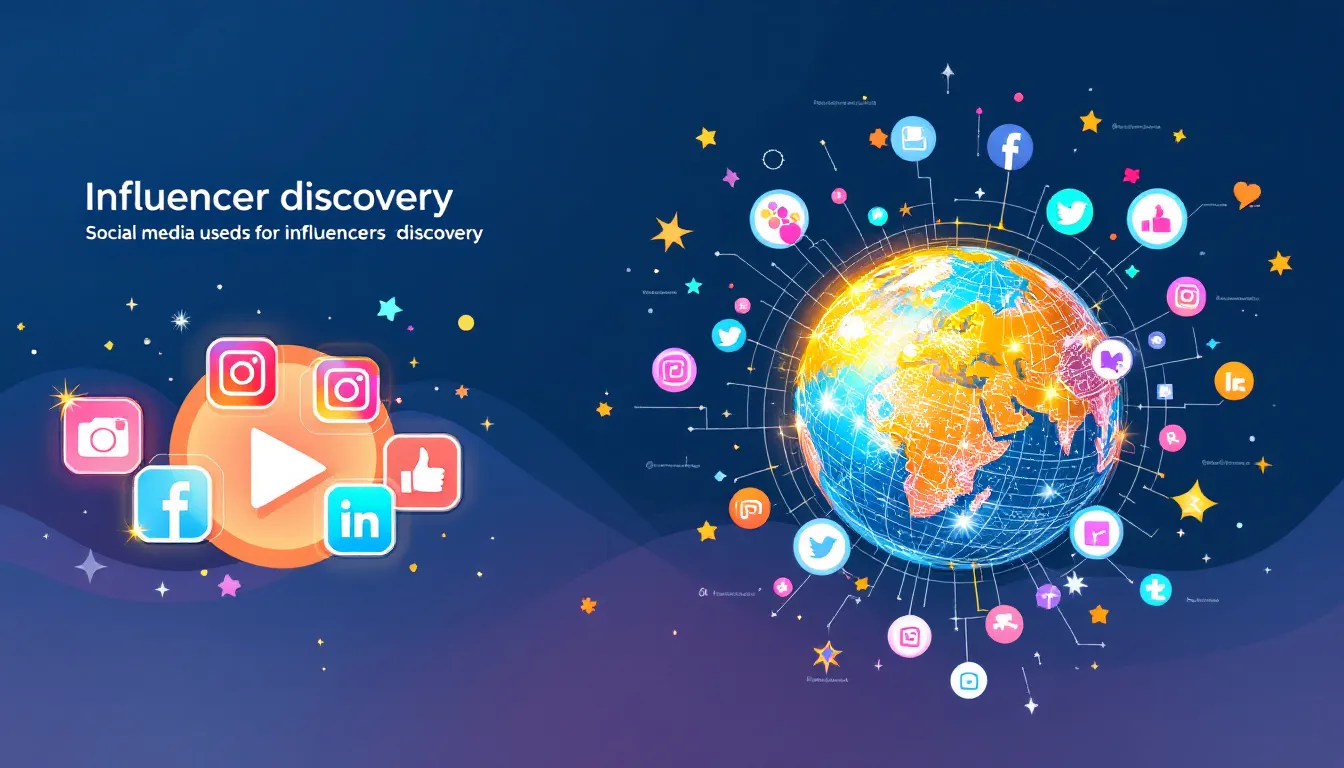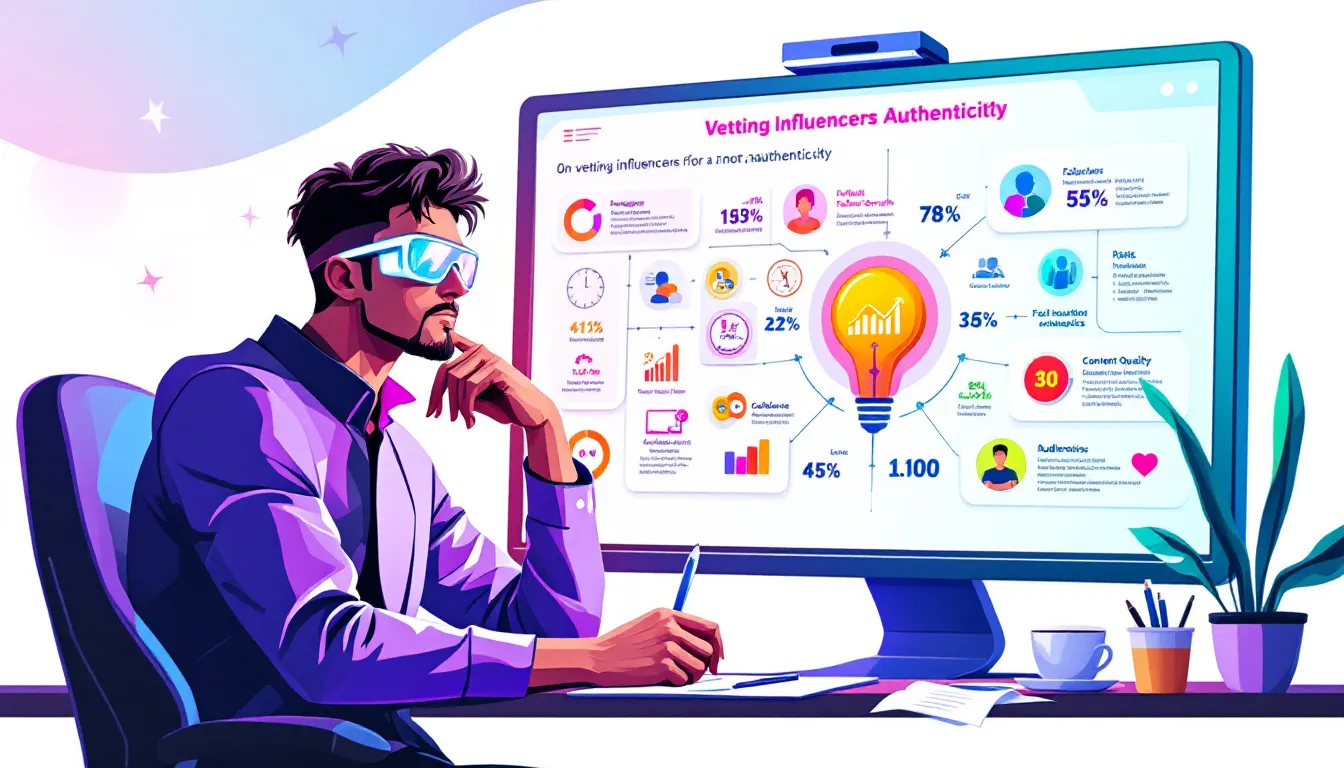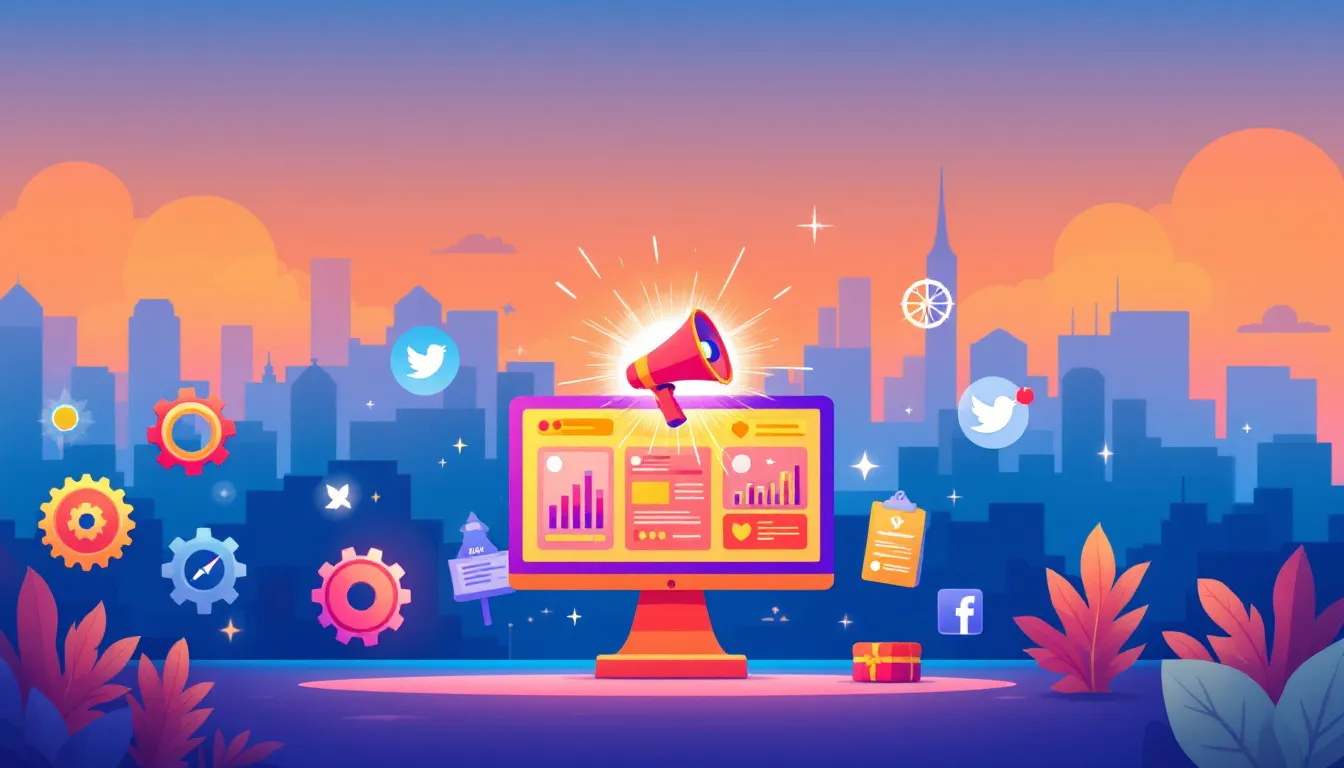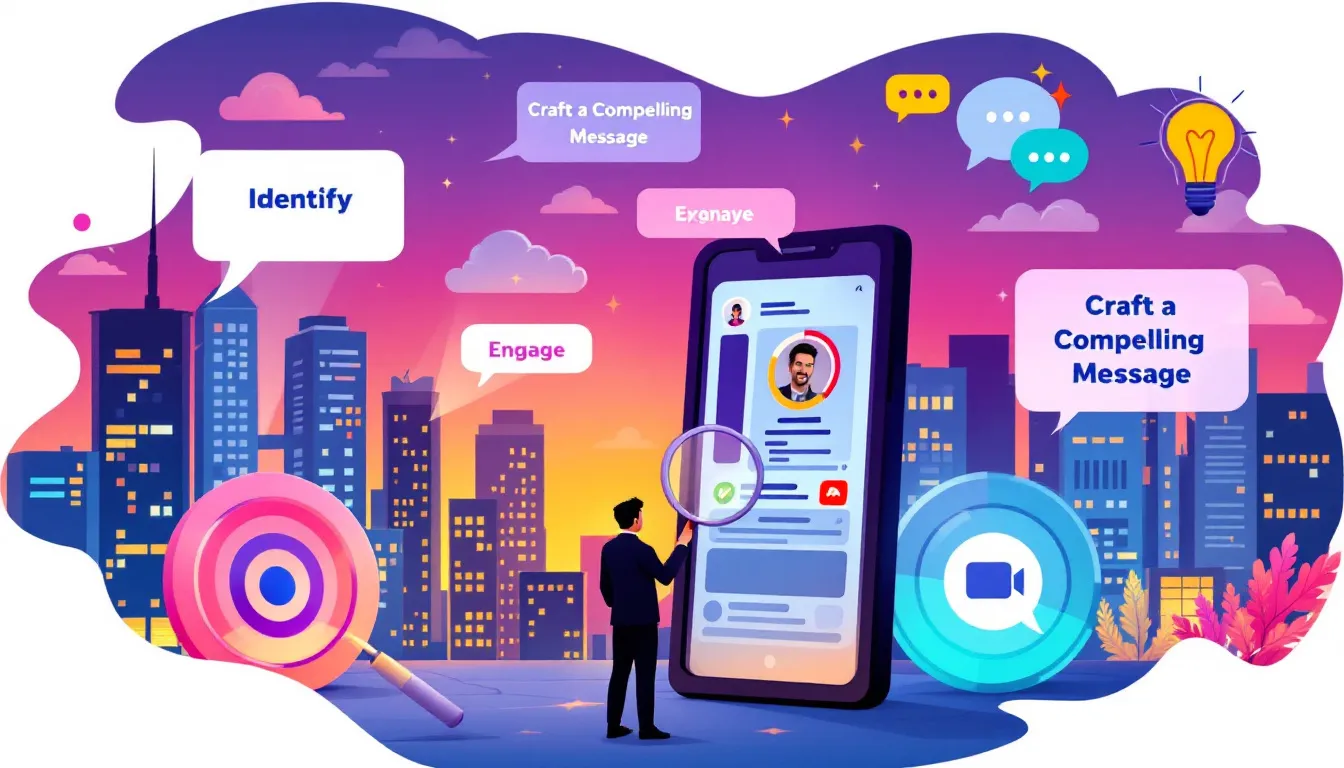The Best Strategies to Find Influencers for Your Brand
Finding influencers is the first key to successful influencer marketing — an industry that’s absolutely exploding right now.
This article will guide you through practical steps to identify influencers and engage the right ones for your brand.
Key Takeaways
-
Identify the right type of influencer—mega, macro, micro, or nano—to align with your brand’s marketing goals.
-
Use influencer marketing platforms and social media to efficiently discover and vet potential influencers, ensuring they resonate with your target audience.
-
Build long-term relationships with influencers for sustained trust and engagement, improving the authenticity and effectiveness of your campaigns.
Understanding Influencers and Their Impact

In the contemporary realm of digital marketing, social media influencers, including Instagram influencers, leverage their significant clout to sway purchasing decisions as powerful social media personalities. They boast substantial followings on online platforms and possess considerable influence within particular areas of interest.
There are four primary categories of influencers:
-
Mega
-
Macro
-
Micro
-
Nano
Brands must ascertain which variety aligns impeccably with their promotional objectives due to each category’s distinct advantages.
Micro-influencers usually command a following ranging from 10,000 to 50,000 individuals and are celebrated for high levels of engagement and robust communities that highly value their endorsements. This makes them an excellent choice for brands looking to cultivate authentic relationships. Conversely, macro influencers have followers numbering between 100,000 and one million people and can reach wider audiences. They’re apt for companies aiming at achieving extensive exposure.
The trust placed in such figures has climbed from 51% in 2019 up to a notable 61% by the year 2023—a testament to the escalating reliability perceived in influencer marketing tactics directed toward enhancing brand prominence and audience interaction. Utilizing these trusted voices can significantly amplify awareness about a brand.
With influencer marketing reaching an estimated worth of $21.1 billion globally in the same year, it showcases its efficacy alongside soaring adoption rates amongst marketers worldwide. Engagement ratios spanning from one percent up towards five suggest formidable evidence concerning an individual influencer’s impact on campaigns—utilizing this medium judiciously may yield improved sales figures along with heightened conversion stats thus underlining its potency as a strategic avenue within advertising pursuits.
It is imperative for businesses seeking success through this channel first comprehend various types (and respective influences) involved before honing strategies geared specifically toward identifying those who resonate most profoundly with your intended demographic—the precision here ensuring campaign effectiveness.
What is an Influencer?
An influencer is an individual who has built a significant following on social media platforms, such as Instagram, YouTube, TikTok, or blogs, and has the ability to influence their audience’s purchasing decisions. Influencers often specialize in a specific niche or industry, such as fashion, beauty, fitness, or gaming, and have a deep understanding of their audience’s interests and needs. They use their online presence to promote products, services, or ideas to their followers, who trust their opinions and recommendations.
Identifying Your Target Audience
Before exploring influencer discovery, clearly understand your target audience. Knowing who you want to reach helps in selecting the right influencers. Demographics like age, gender, location, and interests define your target audience. A well-defined target audience directs your marketing efforts toward those most likely to engage with your brand.
CRM data and social media followers offer valuable insights into what resonates with your audience, helping you tailor your influencer marketing campaigns to their preferences and behaviors. If your audience consists mainly of young adults interested in fitness, partnering with fitness influencers can be highly effective.
Competitor analysis helps identify potential influencers by examining your competitors’ partnerships, revealing successful strategies and influencers who engage your target demographic. This approach not only saves time but also provides a proven pathway to reaching your audience. Selecting the right brand ambassadors, who embody your brand’s values, enhances authenticity and boosts marketing effectiveness.
A clear understanding of your target audience is crucial for a successful campaign, focusing efforts on the right individuals to meet your marketing objectives. Next, explore influencer marketing platforms to streamline your search and management.
Determining Your Influencer Marketing Goals
Before starting an influencer marketing campaign, it’s essential to determine your goals and objectives. What do you want to achieve through influencer marketing? Are you looking to increase brand awareness, drive website traffic, generate leads, or boost sales? Identifying your goals will help you choose the right influencers, create effective content, and measure the success of your campaign.
Some common influencer marketing goals include:
-
Increasing brand awareness and reach
-
Driving website traffic and generating leads
-
Boosting sales and revenue
-
Improving brand reputation and credibility
-
Creating engaging content and building a community
Utilizing Influencer Marketing Platforms
Influencer marketing platforms revolutionized the way brands orchestrate their influencer marketing campaigns, providing a suite of influencer marketing tools within one central hub for engaging, monitoring, and compensating influencers.
These resources greatly simplify the process of identifying influencers who embody your brand’s ethos and objectives through an influencer marketing agency.
Services such as Influencity, Upfluence, Linqia, and Influencer Marketing Hub offer extensive campaign management capabilities by showcasing crucial data like engagement rates, geographical distribution of followers, and overall follower count to support well-grounded decision-making.
For instance, Upfluence’s sophisticated search features allow businesses to accurately locate influencers that match their profile.
Certain platforms focus on enhancing influencer discovery.
HypeAuditor and Modash stand out by delivering deep insights into metrics like audience authenticity quality evaluation while offering powerful options for analyzing ongoing campaign success. With its array of functionalities including analytics tracking alongside competitor analysis research opportunities — all invaluable assets in refining strategies – HypeAuditor is particularly beneficial.
A Live Account Performance tool provides immediate access to updated engagement metrics assisting with choosing appropriate influencers based on aspects such as compatibility with your brand values and financial considerations. By adopting these influential marketing solutions firms can unearth potential collaborator relationships more effortlessly manage those associations during promotional endeavors.
As we move forward, it becomes imperative to utilize social media as a pivotal component in discovering suitable endorsers—a critical step towards ensuring congruency between selected individuals reflecting positively upon your company’s image.
Leveraging Social Media for Influencer Discovery

Discovering influencers who resonate with your brand and appeal to your target audience is optimally achieved through social media platforms.
Utilizing specific hashtags can be a strategic approach to unearth potential influencers producing content that aligns with your niche, such as #fitnessjourney for fitness-oriented brands or #travelgram for travel-related companies.
Exploring posts that are currently trending could lead you to new influencers who are quickly gaining traction within your desired market.
By keeping an eye on the latest trends, you have the opportunity to identify emerging talents captivating their followers, positioning yourself at the forefront by engaging with these up-and-coming personalities.
Taking advantage of built-in tools like Instagram’s Explore page or TikTok’s Discover page can greatly assist in finding suitable influencers for your brand.
These features spotlight content that is both popular and trending, simplifying the process of discovering creators whose dynamic and high-quality material garners substantial engagement rates.
The essence of social media extends beyond mere discovery. It encompasses nurturing relationships and building authentic connections.
Interacting with prospective influencers’ postings and contributing meaningfully to pertinent discussions helps forge a bond prior to initiating any collaboration proposals. Following this discussion, we will explore how analyzing competitors can refine strategies used in locating ideal influencer partnerships.
Competitor Analysis for Influencer Identification
Competitor analysis strategically identifies potential influencers. By examining competitors’ partnerships, you gain insights into successful collaborations and find influencers who have proven effective. This approach leverages competitors’ experiences, helping you avoid trial-and-error.
An influencer marketing competitor audit reveals how rivals use partnerships and highlights successful strategies. This involves reviewing competitors’ social media, analyzing recent campaigns, and identifying key contributing influencers. Understanding the values and messages in competitors’ content helps identify gaps and opportunities for your brand to engage its audience.
Tools to analyze which influencers have worked with competitors reveal potential partners. These tools offer insights into influencers’ audiences and engagement, helping you find creators aligned with your goals. High engagement on competitors’ posts can indicate potential influencers with active audiences.
Competitor analysis is powerful for identifying successful influencers. Next, we explore how AI tools streamline the influencer search process, making it more efficient and data-driven.
Using AI Tools for Influencer Search
Influencer marketing has been revolutionized by AI, streamlining the process for companies to locate influencers who share their values and goals.
Automated solutions like Creators AI facilitate this by expediting both the identification and engagement phases with influencers, thus accelerating campaign expansion efforts.
These applications perform deep analysis of audience demographics, behaviors and content performance to save time and reduce your risk.
In addition to Creators AI, NinjaOutreach and Impulze.ai are popular tools which offer precision-targeted influencer searches complemented by vigilant content monitoring and real-time analytics for managing influencer relationships .
Utilizing these advanced search tools powered by artificial intelligence not only conserves valuable time, but also guarantees alignment between a brand’s core message and its chosen representatives’ ethos.
Engaging With Potential Influencers
Fostering a personal relationship with potential influencers can enhance the chances of successful partnerships. Begin by keeping tabs on these influencers across social platforms and interacting authentically with what they post.
It’s essential to personalize your outreach since influencers are flooded with requests.
Tailoring your communication helps you capture their attention and make them feel appreciated — mention something from one of their recent posts or illustrate how your product resonates with their brand ethos to boost reply and interest rates.
Offering unique content or experiences is an effective lure for collaboration. Granting early access, exclusive encounters, or a peek behind the curtain at your operation renders your proposition more attractive.
Emphasizing shared advantages and ensuring alignment between the partnership goals and influencer’s audience will Encourage cooperation.
Always communicate respectfully without overwhelming potential influencers with excessive messaging. Should there be no reply following an initial pitch, extend a courteous reminder via email later on after some time has passed. Fostering authentic relationships while underscoring reciprocal value are cornerstones in forming lasting alliances with influencers.
Vetting Influencers for Authenticity

It’s essential to authenticate influencer credibility to achieve success in your campaigns. Scrutinize the demographic makeup of their audience, such as age distribution, gender balance, geographical spread, and cultural connections. Confirming this match with your intended target demographic is key.
Next, delve into engagement metrics like likes, comments and shares that signal an influencer’s impact level. Assess these statistics to ascertain authentic user interaction and active follower participation with the content they share. Utilizing tools designed for scrutinizing social media can also pinpoint issues tied to influencers including a prevalence of fake followers or previous disputes.
Conduct thorough investigations into an influencer’s standing by examining their historical content quality and engagement consistency along with any former contentious incidents which could potentially tarnish your brand image. Verifying that there is resonance between an influencer’s principles and those upheld by your brand helps mitigate risks of undesirable affiliations.
For effective due diligence on potential influencers, ensure you evaluate alignment in terms of values as well as assess content relevance alongside subject matter authority when selecting partners. Adopting such detailed vetting tactics supports constructing a reliable marketing strategy within the realm of influencer marketing—setting the stage for achieving anticipated outcomes through collaborations based on trustworthiness.
Assess Influencer Content Quality
When evaluating influencers for your marketing campaign, it’s crucial to assess the quality of their content. Look for influencers who create high-quality, engaging, and relevant content that aligns with your brand values and messaging. Consider the following factors:
-
Content style and tone: Does the influencer’s content style and tone align with your brand’s voice and aesthetic?
-
Content relevance: Is the influencer’s content relevant to your target audience and niche?
-
Engagement rates: Does the influencer have high engagement rates, such as likes, comments, and shares?
Building Long-Term Relationships With Influencers

Establishing enduring connections with influencers is a cornerstone for continuous success in the realm of influencer marketing. When influencers consistently introduce their audience to your brand through such lasting partnerships, it not only enhances trust and community involvement but also significantly boosts conversion rates and nurtures true bonds.
Influencers have shown a preference for authentic relationships that extend beyond single campaigns. Such long-term engagements enable them to weave more credible narratives around the brand, thereby deepening the relationship between their followers and your brand. Brands frequently engage with nano and micro-influencers who are known for strong ties with their communities, leading to higher engagement levels.
It’s critical to uphold respectful dialogue while ensuring timely compensation when collaborating with influencers. This demonstrates an appreciation of their contribution as well as dedication towards a professional relationship. This approach often results in gaining extra organic exposure from these individuals, solidifying your branding efforts alongside increasing its authenticity.
Scouting for potential long-lasting collaborations can pave the way toward stronger relations within target audiences, which ultimately contribute positively towards a robust influencer marketing strategy implementation plan. Subsequently, we will explore strategies on crafting influential campaigns that resonate coherently with company goals.
Creating Effective Influencer Campaigns

To achieve success in influencer marketing, it’s imperative that the strategy is in harmony with the overarching business goals of the brand. Influencer campaigns are adept at targeting a variety of objectives such as elevating brand recognition, boosting website traffic, and enhancing conversion rates. Precisely defining your specific targets for an influencer campaign is pivotal to its effectiveness.
In order to prevent any confusion throughout influencer partnerships, there must be transparent communication regarding expectations and deliverables. Brands need to thoughtfully select influencers based on both their dependability and how well they match up with the campaign’s aims. Scrutinizing an influencer’s past content can provide valuable insight into their consistency with your brand messaging.
Investigating how well previous campaigns have performed under particular influencers can shed light on how impactful they may be and gauge audience engagement levels. To accurately evaluate the triumphs of an influential campaign. Distinct KPIs resonant with what you set out to achieve are vital. This evaluation not only determines whether current strategies were effective, but also informs future decisions powered by solid data.
Factoring in budget limitations from early stages plays a role in selecting suitable influencers as well as shaping the breadth of your marketing endeavor plans effectively utilize resources without compromising potential outcomes when coordinating your marketing approach coherently aligning it strongly focused financial plan aids crafting compelling initiatives that yield substantive benefits.
Industry Events and Conferences
Allocating Budget for Influencer Marketing
Summary
To effectively select the right influencers for your brand in 2024, a comprehensive strategy is essential. This involves grasping the various categories of influencers, pinpointing your intended target audience, employing influencer marketing platforms to assist with this process, making use of social media channels for research and discovery, and analyzing what competitors are doing in their own campaigns. The adoption of artificial intelligence tools can refine the search for influencers by providing more precise and data-informed selections.
The cornerstone of successful influencer marketing campaigns lies in engaging with potential influencers meaningfully—assessing their genuineness as representatives for your brand’s values—and fostering enduring partnerships with them. Align these steps carefully within an overarching influencer marketing strategy that complements your broader business goals while ensuring transparent communication. Such meticulous coordination will drive impactful campaign results.
As we look ahead to 2024, the scope for growth through influencer marketing remains substantial. Brands ready to stay abreast of emerging trends and innovations have opportunities waiting: leveraging influential voices can amplify online presence profoundly as well as propel both user engagement levels and conversion rates upward. Embracing these approaches could elevate a company’s influence through strategic digital initiatives significantly higher than before.
Frequently Asked Questions
Why is understanding the different types of influencers important?
Understanding the different types of influencers is crucial because it empowers brands to select the best partnerships that align with their goals and resonate with their target audience.
By leveraging the unique strengths of each influencer type, you can maximize your marketing impact and achieve greater success!
How can competitor analysis help in identifying potential influencers?
Competitor analysis is key to discovering potential influencers, as it reveals successful partnerships and strategies used by your rivals. By examining their social media and collaboration efforts, you can pinpoint influencers who perfectly align with your brand objectives.
What are the benefits of using AI tools for influencer search?
Using AI tools for influencer search significantly enhances efficiency and accuracy by delivering real-time insights and demographic data.
Embrace these tools to make informed decisions and elevate your marketing game!
How can brands establish successful long-term relationships with influencers?
To build successful long-term relationships with influencers, brands should focus on respectful communication, timely payments, and ongoing collaborations.
This approach fosters trust and authentic engagement, paving the way for impactful partnerships.
What are the key elements of creating effective influencer campaigns?
In order to establish successful influencer campaigns, it is essential that they are in harmony with the objectives of your business. You need to define precise aims and convey what you expect clearly.
Keeping a close eye on content and evaluating how well it performs allows you to confirm the prosperity of your campaign as you conscientiously manage your financial resources.
